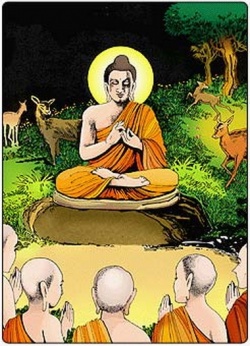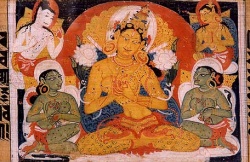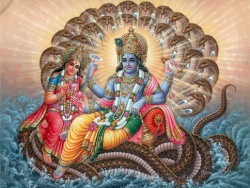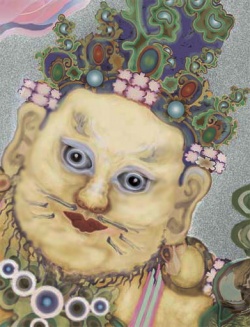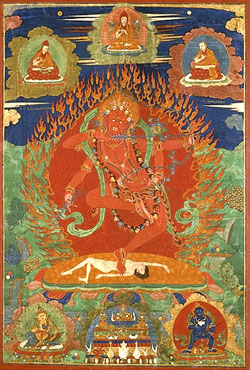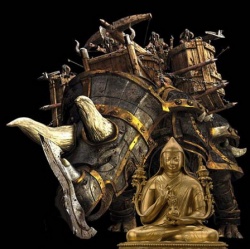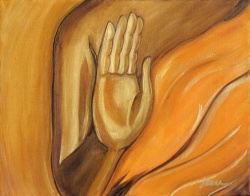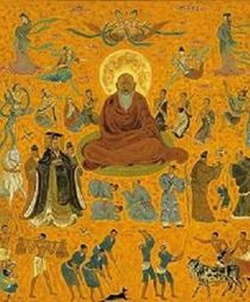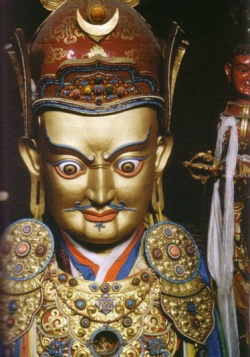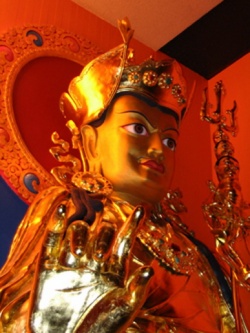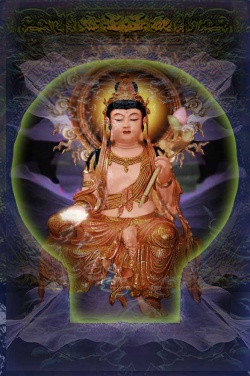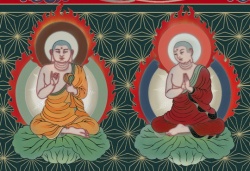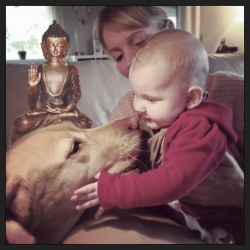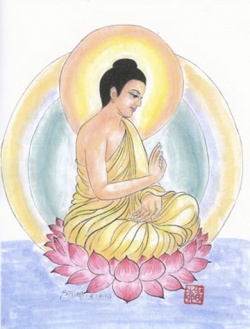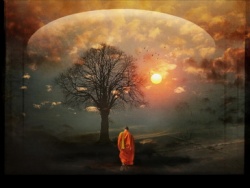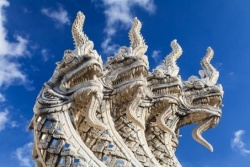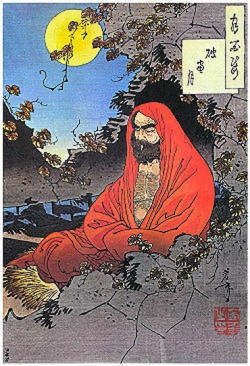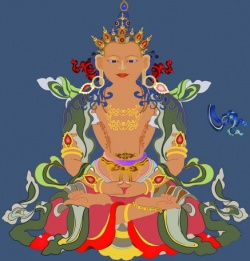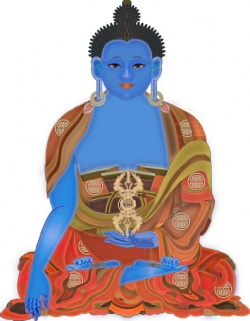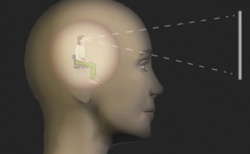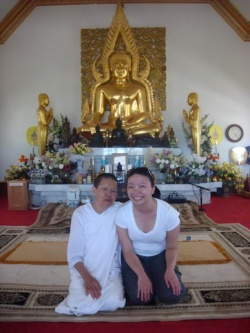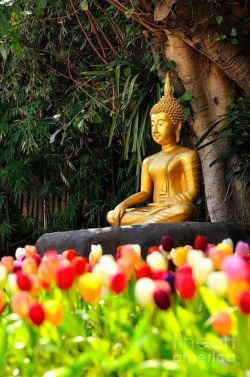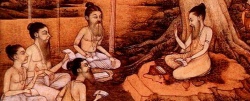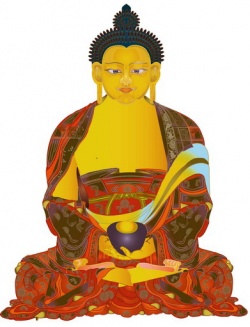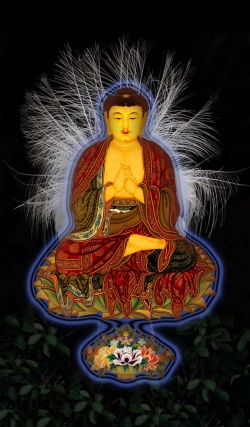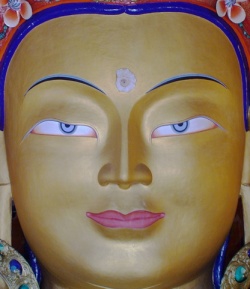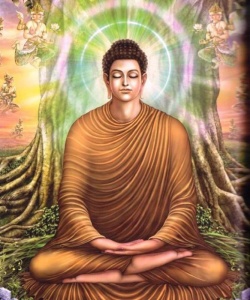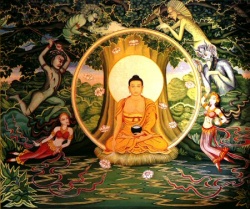Manual of Pramana - CLASS NOTES part 1
Class One: Why Study Buddhist Logic
Introduction
Gyaltsab Je was the main disciple of Je Tsongkapa (1357-1419), who started our lineage and was the teacher of the first Dalai Lama. “Gyaltsab” means “regent,” and he was assigned as Je Tsongkapa’s replacement, but before these two met, Gyaltsab Je was the most famous logician in Tibet. After becoming one of Je Tsongkapa’s great disciples, Gyaltsab Je said that the kindest thing Je Tsongkapa ever did for him was to teach him Buddhist logic.
Each class in this course will include three parts:
1. The content of Buddhist logic.
2. The format or structure of Buddhist logic.
3. The form of Buddhist debating.
Logic Textbooks and Authors
TSEMA NAMDREL Commentary on Valid Perception, written by Lopon Chukyi valid perception commentary Drakpa, Master Dharmakirti (650 ad). This classic logic pramana - varttika (skt.) text is a defense of an earlier book on Buddhist logic written by Master Dignaga who was the founder of Buddhist logic.
Valid perception means perception that is reasonable given the information available.
Based on what you know at the time, it’s true. However, perceptions that are valid may prove to be incorrect upon further analysis.
RIK LAM TRUL GYI DEAMIK The key for Starting the Logic Machine. This is logic path machine of starting key the standard logic textbook at Sera monasteries.
It was written by:
PURBUCHOK JAMPA TSULTRIM GYATSO The author (1825-1901) for the modern commentary which we will use for this course. He was tutor to the thirteenth Dalai Lama.
1. Studying Buddhist logic allows you to see emptiness directly. Gyaltsab Je said the kindest thing Je Tsongkapa ever did for him was to teach him Buddhist logic. If you are ready, studying logic triggers your intellectual capacity, and powers you to see emptiness directly — especially the study of mental images (chi-jedrak).
Students can be described according to their level of intellectual and spiritual capacity:
WANG TUL DEPAY JEDRANG To follow Buddhism from blind faith is
power dull faith to follow stupid, for those with “dull power.” Faith somebody is unstable, and to follow a teacher because they are attractive or appealing is foolish.
WANG NUN RIKPAY JEDRANG To follow because of reasoning is smart power sharp reasoning to follow for those with “sharp power.” Don’t somebody accept what any teacher says until it makes sense to you logically.
2. TEN – DZIN To hold as true. It means “keeping the Dharma safe in the true to hold world.” The great Sakya Pandita said the only people qualified to keep Buddhism safe in the world are those who understand and can logically prove the truth of Buddhism.
DETA DRUP DANG SUNJIN GYI RIKPAY SHANLUK GANGI SHEY
like that to prove and disprove of logic books that teach anyone who understood
KEPA DENI DZOKPA YI SANGGYE KYI NI TENPA DZIN
Buddhist that guy totally enlightened Buddha of keeper of Dharma master
Suppose a person comes to understand the scriptural tradition for how to reason: this art of proving or disproving things. A master like this is a person who keeps the teachings of the totally enlightened Buddhas safe here in the world.
If you can’t prove your Buddhist faith to yourself, the teachings will disappear. You must understand why you believe the Dharma. If doesn’t make sense to you, drop it. If it does make sense, then drop the other stuff and follow this.
3. NGA’AM DANG DRAWE GANGSAK GI TSU ZUNG GI
me or and one like me other people of you can judge them but…
GANGSAK GYI GANGSAK GI TSU MISUNG TE NYAMPAR GYUR TARE
other people than me other people you can’t judge them you’ll fail you’re going to
If you are me or someone like me [a Buddha) you can judge other people, but… other people [non-Buddhas] shouldn’t judge other people or they will fall down.
Only a Buddha who is omniscient can read other people’s minds directly without getting into trouble. If you are a normal person, logically, you have to be very careful about judging other people because you can’t see what is in their mind. It doesn’t mean that you should let an apparently evil person do harm to others, etc. You should react to these situations and resist evil, but you should reserve final judgment. The most important lesson of Buddhist logic is that you don’t know who the people around you are. You don’t know their motivations, or whether they are a bodhisattva or a tantric deity, so you should just concentrate on your own practice. Don’t judge or criticize others.
The Definition of a Reason
TAK SU KUPA TAK KYI TSENNYI The definition of a reason is
reason as a set forth reason of a definition anything you give as a reason.
“It’s right to study Buddhism because the sky is green.” The sky being green is a reason; it doesn’t have to be a good reason. Anything you want to give as a reason will qualify as a reason. It doesn’t have to be correct, and it doesn’t even have to exist. Anything you put forth as a reason is accepted as a reason.
The Right Motivation for Debating
NYI KU – RIM Prayers said by monks before beginning a debate session. The first
thing you do when you arrive at the debate ground is to pray that you will have the right motivation for debating: to explore reality with your friends, and to get to the bottom of the truth so that you can get enlightened as soon as possible and then help other people. Debating quickly speeds you to the direct perception of emptiness which will quickly get you to Buddhahood so you can then help people in a big way. You have the potential to save people’s lives by teaching them how to stop their suffering and their own death. This is the only motivation you should have for debating.
Class Two: Changing and Unchanging Things
DURA A kind of literature where great Buddhist masters from each college have logic text taken important ideas out of Master Dharmakirti’s Commentary on Valid Perception (Pramana Varttika), and made separate books from them.
Three Logic Texts
1. YONG DZIN DURA The Key To the Logic Machine, by Purbuchok, who was tutor of Dalai Lama logic text the tutor to the thirteenth Dalai Lama.
2. SE DURA Logic text written by Ngawang Trashi (sp?) who is the spiritual logic text spiritual son of the great Jamyang Shepa, the textbook son/daughter writer from Gomang college of Drepung monastery.
3. RATU DURA The first great dura, written at Ratu monastery near a monastery logic text Hlasa.
Three-Section Structure of Logic Texts
The structure of each dura (logic text) includes approximately 15 important topics, which are presented in three distinct sections (called gak shak pong sum):
1. GAK To choke someone. It means to blow away the incorrect arguments of to choke your opponent. Approximately 15 incorrect views are presented, then correctly refuted.
2. SHAK To set forth your own correct views. It includes definition, divisions, and clarifications. This is the critical section where our own correct views are presented.
3. PONG To refute your opponents’ rebuttal.
to eliminate
The logic texts begin with an opponent opening with an incorrect statement which challenges the defender to correct their false opening statement. You begin a debate with this statement:
DI CHITAR CHU-CHEN Let’s consider this topic… Then you open with an wisdom let’s consider… incorrect statement which is disproved by the defender.
Presentation of All Existing Things
SHI-DRUP KYI NAMSHAK Everything you always wanted to know about outline of all of types of things things you can establish as existing. Buddhism of existence divides all of existence into categories and subcategories.
Understanding this topic is very important because it will help you to see emptiness directly
Synonyms for “Existence”
YUPA Existing things. Anything that exists.
SHE JA Knowable thing. Any object in the universe that can be known.
CHU Dharma, any existing thing. This is one of the many definitions for Dharma.
SHI DRUP Anything that can be established as existing.
YUL An object, any thing.
Any one of these words can be used for one specific existing thing, or for the category of all knowable existing things in the universe.
An Outline of All Existing Things
TSEME MIPA YUPAY TSENNYI The definition of an existing thing is that
valid perceived existing definition which can be perceived by a valid perception thing perception. Almost all of our perceptions during the day are valid, except for when we are very emotionally upset, drunk or hallucinating, seeing an optical illusion, etc.
YUPA Existing things. We will divide all of existence into unchanging existing things things and changing things.
Unchanging Things
TAKPA Unchanging thing. Takpa is sometimes translated as “permanent” unchanging thing which means it will last forever and never stop. However, takpa should be translated as “unchanging” rather than as “permanent,” because emptiness, which is the classic example of takpa, is unchanging but is not permanent. As long as the emptiness of the pen exists, i.e., the fact that the pen doesn’t have any nature of its own, that emptiness is completely unchanging. Then when the pen is destroyed, its emptiness goes out of existence, but its emptiness doesn’t gradually diminish. So because the emptiness of the pen doesn’t last forever, takpa should be translated as unchanging rather than permanent.
TONGPA NYI Emptiness (shunyata, skt.). This is the classic example of an empti – ness unchanging thing. Emptiness comes into and goes out of existence, but it doesn’t start or end.
A Definition of Unchanging Things
KECHIKMA MA-YINPA TA-MADRUP DU SHOK
changing by the instant not it is that is wrong right what’s wrong
To “not be changing instantaneously” is a bad definition of takpa, because a correct
definition must include to “not be a thing that changes by the instant.” The point here is that things that don’t exist, like the horns of a rabbit, could be considered to be unchanging, but they are non-existent – they are not objects that exist. So you must define unchanging things as existing things that are unchanging.
KECHIKMA MA-YINPAY CHU
changing by the instant not it is thing
An existing thing that is not changing instantaneously. This is the correct definition of an unchanging thing.
Changing Things
MI-TAKPA Changing thing. Things can be changing in a gross or subtle changing thing way. That something breaks right in front of you is its gross changing nature. That almost every kind of object is wearing out moment by moment is its subtle changing nature. In fact, Buddhism says that the very creation of an object is the cause for its destruction.
KECHIKMA Subtle impermanence. That which only lasts for an instant.
changing instantaneously This is the correct definition of a changing thing (mitakpa).
KAWA, BUMPA A pillar or stick holding up the roof of a grass hut, and a water
pillar water pitcher pitcher sitting in the corner of the hut. These are the two traditional examples of changing things used in ancient India.
Functioning things
NGUPO Functioning thing. Anything that does something. This is a
functioning thing synonym for a changing thing (mitakpa). Anything in the universe that changes is a working thing.
DUNJE NUPA NGUPUY TSENNYI Anything which does something is the
to do function functioning definition definition of a functioning thing. You can something thing call it a working thing.
Is emptiness a working thing? If not, it would have to be an unchanging thing. So what’s the point of seeing emptiness if it can’t function to get you to enlightenment? Consider that there’s a difference between emptiness itself, versus the perception of emptiness.
Three Categories of Changing Things
1. SUK A physical thing. This is also called pembo which means a thing physical composed of atomic particles.
thing
SUK SU RUNGWA SUK KYI TSENNYI, TSAWAY REKJA
physical thing shown as physical object of definition hot tangible feeling
The definition of physical matter is anything that can be demonstrated as physical matter. For example, an object that is hot to the touch. If you try to explain to someone what the color blue is, the only way is to point to something that is blue.
2. SHEPA A mental thing. This refers to your thoughts, not your main mind.
mental thing These are the thoughts that are in your mind, not the mind itself.
SEL SHING RIKPA, SHEPAY TSENNYI, DEWA, YESHE
invisible and aware mental thing definition happiness wisdom
The definition of a mental thing is something invisible and aware; for example, happiness and wisdom. The word sel usually means clear, but here it means invisible. The mind is clear and knowing. In the West we usually confuse the mind with the brain. This is silly because the mind is ineffable. It can not be located or touched. It goes beyond the borders of your skin.
3. DENMIN DUJE BEM SHE GANGRUN MAYINPAY DULJE GANGSAK
doesn’t working physical mental either one it is not produced a person possess thing matter thing thing
The definition of an active thing which is neither mind nor matter is a produced thing which is neither mind nor matter; for example, a person, Tessie. “Person” is a concept which cannot be touched (like the body) or irritated (like the mind). You are the combination of your body and your mind, but you are not either one itself. Tessie is an idea that covers her body and her mind, and it is a changing thing. Another example is a bakjak, a mental seed that resides in your mind.
The Subject, Quality and Reason of a Debate
DI CHITAR CHUCHEN Let’s consider this one. You begin a debate by
mantra of this one let’s consider introducing the topic.
TONGPA NYI CHUCHEN Let’s consider emptiness.
emptiness let’s consider
NGUPO YIN TE It’s a working thing.
working thing it is
DUJE NGUPA YINPAY CHIR Because it performs a function.
function it performs it is because
CHUCHEN The subject of a debate. It means “let’s consider…” For example, let’s
the subject consider emptiness. The subject must have two qualities:
1. The opponent must have perceived the subject with a valid perception; they must be somewhat familiar with the topic.
2. The opponent must be unsure whether or not the subject has the qualities you will assert. Your reasoning is considered incorrect if the opponent already believes what you’re trying to prove.
DRUPAY CHU The quality of the subject you’re trying to prove. For example, “being
prove quality a working thing.” It doesn’t even have to exist; you just have to be willing to prove it. You and the opponent must agree that it is the quality you’re trying to prove.
DRUPJA The assertion, which consists of the subject and the quality you’re
assertion trying to prove. For example, “emptiness is a working thing.”
TAK The reason. The reason may include anything you want to say as a
reason reason. For example, “because it performs a function.” Buddhist debate is all about exploring the unknown with your friends. It’s a beautiful thing. It’s not about the idea of competition that Americans typically have. Don’t be shy, which is a kind of pride. Be courageous and try to sharpen your understanding by debating topics you don’t understand well.
Note that this course on logic falls within the sautrantika, or logic school. In this school, the definition of ultimate reality is “anything you can confirm directly with your senses.”
Class Three: The Door to Emptiness
The goal of this course is to be able to sit in a chair and help every living being in the universe perfectly without any conscious thought. This is called hlundruk, to be a perfect match with every living being and to help them unconsciously. To do this, you must be a Buddha, and to become a Buddha you must have reached nirvana which is the permanent removal of all of your mental afflictions, because you saw emptiness directly. So to remove all of your mental afflictions you must first see emptiness directly; and to see emptiness directly, you must first reach the realization called chu chok, or “supreme object” where you directly perceive and understand perfectly what it is to be dependent origination (lower reality), and how it works; and before you reach chu-chok you must first study emptiness deeply and understand how mental images work. If you understand mental images well you eventually will see directly how lower reality works; then you will perceive higher reality directly very shortly afterwards. So studying mental images is a direct lineage to reaching Buddhahood. The whole essence of Buddhist logic is to understand mental images and dependent origination.
The study of mental images is very difficult because you need some kind of energy or power to get it. You must have a great collection of good karma, which gives you the ability to understand this topic. Without this good karma you will not be able to absorb these teachings. This material is extremely important and you should go through each argument in the reading slowly and work on it one bit at a time. It will take a lot of effort.
CHI JEDRAK “General” and “specific,” or “set” and “subset” are easy general specific member simple definitions for chi-jedrak. We will illustrate the category of that category the concept of general (chi) and specific (jedrak) using the example of “car.” If car is the general (chi), then Chevies,
Fords and Toyotas can be specific instances, or subsets of “car.” It is also true that every specific (jedrak) can also be a general (chi). For example, if Chevies are the general (chi), then old Chevies and new Chevies can be the specific (jedrak). A very general test of whether something is a chi of a jedrak, is that if you wiped out all of the chi’s, it would automatically wipe out all of the jedrak’s. Two of these next three are only nominal chi’s — they are not real chi’s; and one of them is a real chi.
Three Types of CHI, or “Quality”
1. RIK CHI A type or kind, which has individual things which are characteristic type, kind of it. It is formally defined as “that existing thing which subsumes the multiple things which are of its type.” It means, it’s a general quality (car-ness), and many things are characteristic of it.
You must think carefully about this: think of car as “car” or the quality of car-ness. It’s the difference between a car, the car, and “car.” This is a life or death question. Car-ness is not the same as a car. Car-ness is a quality, an attribute, a nature and then there are different objects in the world that possess or are characteristic of that quality. For example Chevies, Fords, and Toyotas. The way that your reality is occurring is closely tied to the question of car-ness. The reason you’re perceiving your reality the way you do, and the reason you’re suffering, is directly related to understanding car-ness and the quality called “car.” This is very very subtle and you have to work on it. If you understand this point, you will understand dependent origination and see it directly, and this will trigger the direct perception of emptiness. Then you will see your future enlightenment directly and you will know how many lifetimes you’ll have left and the nature of those lifetimes. You’ll know what you’ll be doing and how you will live. You will see the Buddha directly and you become an arya, or “superior being.” Then you will never doubt these truths, and you become very independent of everything going on in the world. You see the contents of the entire scriptures on emptiness. You see all these things and know they are true, so they are called the four arya truths.
So you must think of chi jedrak as “quality” and “characteristic of…” Don’t think of it as “a characteristic,” like blueness or whiteness is a characteristic of this pen. Think of it as “characteristic of…” or “typical of…” like a Chevy is characteristic or typical of the quality called car-ness. You have to work with this.
To understand this concept, you must pray for the help of your Lamas, and get divine assistance. Do really good preliminaries and visualize the Lamas and ask for help. Heavy duty guru yoga would be in order. You need to collect very powerful good karma to understand chi jedrak.
“Car” means the quality of car-ness, and those objects which are characteristic of car-ness. You must go home and think about this.
2. DUN CHI A mental image. It can be defined as having these three aspects: mental image
1. It’s a mental image of something you’ve already perceived, like your refrigerator.
2. You mistake it for the actual object. The madhyamikas explain it like this. After studying chi jedrak like crazy, you’re making tea in a pot for your Lama, for example, and suddenly you realize that you’re not looking at a pot, you’re looking at a mental picture of a pot, because all there is is a circle of silver, a black long thing, other clues or indicators that your eyes can see. Your eye can’t see a pot of water. It can only see colors and shapes, and then your mind, under the influence of, ruled and dictated by your past karma, organizes that data into a certain object.
Then your mind fills in the blanks and creates a mental image (dun chi) of a pot.
You’re actually staring mentally at an image of a pot in your mind, and then you mistake that for a pot because all you’re actually getting is some sense data. A roach on the stove getting the same sensory data input, because of it’s karma, would interpret that data as a life-threatening hell realm with a burning hot floor — validly so. It’s no more a pot than a hell-realm floor. The roach would also be mistaking his mental image of a mountain of burning-hot metal as an external object. He’s also looking at a mental image (dun chi) and not a real object – and that’s what makes him a roach. He is a roach because of the collective impressions that his karma is forcing him to have about the same sense data that you’re getting. Your karma is forcing you to organize things into mental images (dun chi’s) that are much more comfortable normally. This is what makes you a human. Your karma is the human realm. There is no self-existent human realm independent of the mental images that force you to interpret the same sense data as a human realm. This makes tantric enlightenment possible, and you must change your karma so you will see the data around you as the nectar of the gods. Mental images (dun chi’s) are running your world and they make everything possible. Every single mental or physical event in your world is a mental image, and you’re mistaking them for some outer object. When you do this, you like and dislike, and then you get into trouble. Only when you think of the object as being out there, and as not depending on your own mental images that you have created, can you dislike or like someone in the wrong way, and collect negative karma by having these negative emotions. If you really saw that everything that you experience is your fault, like every jerk you ever met is just something that you’re maintaining, then you wouldn’t get mad at anyone. You would just go home and be sad that you haven’t kept your vows and so have lousy karma. If you changed your karma you would be freed from your bad karma and reach nirvana, because you understood the emptiness of your world.
To understand emptiness you must investigate the intimate relationship between a rik chi and a dun chi, between car-ness and your mental image in your mind when you think of a car. It will liberate you if you see the connection.
3. You arrive at it by negating all which it is not and then the mental image of the pen, for example, is all that’s left. Take everything which is not the pen and cancel it, and you are left with only the pen. According to sautrantika school, this is a mental exercise you do every time you see something. This is not a crucial point; it’s more important to think how your past karma is causing you to see this particular mental image in the way that you do.
A classic example of a mental image (dun chi) is “the opposite of all that a pen is not as I imagine it while I perceive something, and that which I mistake as the real pen.”
If you explore this question it will take you very close to seeing emptiness: what is it in your mind that allows you to look at the parts of an object and organize its parts and to then understand that those parts make a larger object? The answer is that your past karma forces you to see it that way, which is what makes tantric enlightenment possible in this life.
3. TSOK CHI A physical collection of parts. Physical members that make up a group, collection whole. Tsok means a group, and chi here means a general object that has its own parts. For example a water pitcher is composed of a handle, a base, etc. One particular car is composed of its physical parts. This is only a gross nominal chi and is not very helpful in seeing emptiness directly. Seeing how a car is a collection of its gross physical parts will not help you to see emptiness much.
By contrast, understanding the process of how you conceptualize car-ness when you think of a car could get you to see emptiness which will lead you to enlightenment. This is the key to seeing emptiness. You must go home and meditate about this for about five years. It’s worth it.
JEDRAK, or “Characteristic of…”
JE DRAK A member of a general category is a simple definition. The real characteristic of… meaning is “characteristic of…” a quality. Two classical example are:
1. NGUPO A working thing. This is a synonym for a changing thing. It is working thing characteristic of all existing things.
2 BUMPA A water pitcher, which is characteristic of a working thing. water pitcher
Three Tests for Being a JEDRAK
Is water pitcher a characteristic of (jedrak) the general category (chi) working thing (ngupo)? There are three tests for whether something is characteristic of (jedrak) of a general category (chi).
By the way, like every bit of Buddhist scripture, understanding these logic topics has a direct impact on your getting enlightened. All the topics are essential, and you have to get a good explanation of their application. If you could come to see that every scripture (ka) is directly relevant and applies to your personal enlightenment (dam), you could be called a ka-dampa, which means you understand that the Buddha didn’t say anything that won’t get you to your personal enlightenment.
1. KYU NGUPO YIN
it working thing is
Is the object a subset or characteristic of (jedrak) the set/general category/quality (chi)? A water pitcher is characteristic of (jedrak) the general category (chi) working thing. A Chevy (jedrak) is characteristic of the general category car (chi). The characteristic (jedrak) must be only one component, or a subset, of the quality (chi). For example, all working things and all changing things are equivalent — just two different names for the same thing — so one can’t be characteristic of (jedrak) the other as a general category (chi).
2. KYU NGUPO DANG DAKCHIK TU DREL
it working thing related to to be one is to be the other to share a relationship
The characteristic (a water pitcher) shares a relationship with the quality (working things) such that to be one (a water pitcher) is to automatically be the other one (working thing). Being a water pitcher is automatically to be a working thing.
3. KYU MAYIN SHING NGUPO YANG YINPAY SHI TUNPA DUMA DRUP
it is not and working thing it is one thing which many there exists
is both A and B
There must exist multiple other things which are both a) not the subject or characteristic in question (a water pitcher), and b) are still a characteristic of the quality (working things). For example, for a water pitcher (the subset) to be considered a part of the set working things, there must be multiple things other than water pitchers that are still working things. There must be multiple subsets to make up a set. In the example of “car”, there are many other objects which are characteristic of the quality car-ness that are not Chevies (for example, Fords, Toyotas, etc.).
According to the highest school of Buddhist, every single perception you’ve ever had until the day you see emptiness directly is mistaken. You’ve been mistaking the mental image of a thing for the thing itself.
Is Sound a Changing Thing?
Some non-Buddhists in ancient India claimed that the syllable “OM” is an unchanging eternal thing. Buddhists disagree. In fact, sound is changing instantaneously, and this is a metaphor for everything in your life. The Buddhists present the following argument:
DRA CHUCHEN Let’s consider sounds. This is called the subject, or chuchen. sounds let’s consider
MITAK TE They are changing things. This is called the quality, or
they’re not drupjay chu; that sounds are changing things is the assertion, unchanging things or drupja.
CHEPAY CHIR Because they are made. (This is called the reason, or tak.)
it’s made because
The sound “OM” is a changing thing, because it is made or produced. However, the fact that sounds are changing is itself unchanging. Facts are unchanging things. The fact that sounds are changing is truth itself, and truth never changes. The set of all things about which you can say “sound is changing” is exactly equal to the set of all things about which you can say “they exist,” which is exactly equal to the entire set of things about which you can say “they have no nature of their own; they are only my projections, they are empty.” These are exactly equivalent sets; they never change.
A Group of Similar Cases
TUN CHOK A group of similar cases, which means things that are similar to
to be in group of he quality you’re trying to prove. So if sounds is the subject, the harmony objects whole set of all changing things is the group of similar cases.
DRUPJAY CHU The quality you’re trying prove.
the quality object
A Group of Dissimilar Cases
MITUN CHOK A group of dissimilar cases. Truth itself depends on whether
to not be group of hese three relationships hold together. These three kinds of in harmony objects things are dissimilar to the quality “changing thing.”
1. MEPA MITUN CHOK Non-existing things. For example, a sky flower
non-existent dissimilar cases hich could grow out of thin air, or the horns of a rabbit.
2. SHENPA MITUN CHOK Something other. A thing that is too big to be
other thing dissimilar cases imilar to the object being considered. For example, “all existing things.”
3. GELWA MITUN CHOK Directly contradictory or opposite. For example,
contradiction dissimilar cases “all unchanging things.”
Two Objections To a Logical Statement
CHIR Because… This “because” indicates the reason. It comes at the
because end of the reason.
DRA CHUCHEN Let’s consider sounds…
sounds let’s consider
MITAKTE They are changing…
they are changing
CHEPAY CHIR Because they are made.
it’s made because
There are two ways to object to an incorrect logical statement that ends with chir (because):
1. TAK MA DRUP No! Your reason is not correct. Consider the sky; it has
reason not correct color because it’s green. The reason doesn’t correctly apply to the subject. The sky is not green.
2. KYAPPA MA JUNG No, it’s not necessarily so. Consider the sky; it’s green
to cover not it is ecause it has a color. The reason (because it has a color) is correct, but it doesn’t prove the assertion (that the sky is green).
If the logical statement is correct, you just agree with it by saying “it is,” or “it does.” For example, consider the sky, it has a color, because it is blue. You would respond “it has (a color).”
Class Four: Causes and Results, and What Makes a Reason Correct
Comments On Class Three
MING-DE SHAK-TSAM Established through a name (thought) and a term. This
name term s how the madhyamika prasangika school defines dependent origination. This is the only existence that things have. You should consider the relationship between the term quality, and qualityness (“quality,” meaning a mental image), and a quality, and the quality. For this course, you should choose one small argument, and contemplate and meditate on it. Don’t try to read through the readings like a novel. Be sure to read the middle sections of each reading which describes the correct viewpoint.
RIKPAY DROTANG The way it goes. This term describes the flow of the arguments
logic how it goes n the debates – the way they are structured.
Causes and Results
GYUN DRE Causes and results. We will study the shorter and easier of the two
causes results presentations from the Dura.
KYE – JE GYUY TSENNYI Anything which brings about another thing is
to bring about cause definition the definition of a cause. The three following words are synonyms:
DREBU Result. It also means rice or fruit, which is the result you’re hoping
result for. Anything that is a result is also a working thing and a cause.
NGUPO Working thing. Anything that performs a function must be both a
working thing result and a cause.
GYU Cause. Every cause must be a working thing and a result.
The text emphasizes that anything that does anything is automatically a cause; anything that is a cause is automatically a result. Even the last moment of the flame of a butter lamp causes the perception of darkness.
Direct and Indirect Causes
NGU GYU Direct cause. GYU GYU Indirect cause.
PEN GYI NGALOK SU JUNGWA
pen of flopped over the object as it was a moment before
The pen as it was a moment ago. The present thing that flopped over into the present.
This is an example of a direct cause. So an example of an indirect cause would be the pen as it was the moment before the moment before (pen gyi ngalok su jungwa ngalok su jungwa). In Abhidharma, all the events of the past that didn’t prevent the construction of a building are considered to be its causes. In meditation, you’ll start to become aware of all the indirect causes of your current mind. You can trace your thoughts backwards far into the past and see the stream that led to your current thought. If you meditate regularly you can do this — especially with Dharma teachings.
Material Causes and Contributing Factors
To understand why you have been here before in past lives, it is necessary to draw the distinction between material causes and contributing factors. This is the main application of this division of causes.
NYERLEN GYI GYU Material cause. A person can be a cause for a water pitcher, but
material of cause the clay is the material cause, the stuff that turns into the water pitcher. So we say the potter is the contributing factor or secondary cause of a clay pot. A seed is the material cause of a tree, and sunlight, water, time, etc. are the contributing factors.
RANG GI DZE GYUN DU TSOWOR KYE-JE
its stuff continuation as a primarily brings about
Anything which brings about something else primarily as a continuation of the same stuff is the definition of a material cause. Stuff can be physical or mental.
HLENCHIK JEKYEN Contributing factor. Contributing factors for the first moment
contributing factor of your mind in your mother’s womb are your parents, the sperm, the blood, the fact that they had relations, etc. If your parents’ mental material were the material cause of your mind, your mind would automatically share the qualities of their minds, which it doesn’t.
One of the proofs for past and future lives is that there must have been a moment of consciousness prior to this life that turned into the first moment of your mind in your mother’s womb. You can trace your thoughts back logically to the first conscious moment in the womb. Then look for the thing that flopped over from the bardo into that first moment of consciousness.
The Definition of a Result
KYE-JA DREBUY TSENNYI Anything brought about by another
anything brought result definition thing is the definition of a result. Results about by another can also be divided into results of material causes and results of contributing factors.
Two Types of Relationships
There are two types of relationships between two different objects.
1. Relationship of Identity. This is the relationship between a quality and a characteristic, between car and Chevrolet: to be a Chevrolet is to be a car. This is called a ngowo chikpay drawa which means that to be one is to be the other automatically. The test for whether a relationship of identity exists is that if you remove one object the other one will also disappear. If you removed all cars in the world you would automatically remove all Chevrolets. So Chevrolet shares a relationship of identity with car, but car does not share a relationship of identity with Chevrolet (if you remove all Chevrolets all cars don’t necessarily disappear. So this is a one-way relationship.
2. Cause and Effect Relationship. Normally causes and effects are in a one-way relationship: if you remove the cause you will automatically remove the result, but if you remove the result the cause can still have occurred. However, according to madhyamika prasangika, in terms of naming and identifying the cause as a cause, it’s result also must exist, so they would get fancy and consider cause and effect to be a two-way relationship: the result depends on the cause; but the cause, in order to be a cause, also requires that it’s result has also occurred.
There are only three possibilities for every pair of objects in the universe: they will either be in a relationship of identity, in a relationship of cause and effect, or not be in a relationship at all.
Cause and Effect According to Madhyamika Prasangika
The logic school considers cause and effect to be a one-way relationship. However, one of the proofs for emptiness is the fact that there is never a moment when the cause and the effect both are existing together at the same time. So it is impossible that a cause can bring about a result, independent of your projections. There is never an instant when the seed became a tree self-existently. Similarly, when the last moment of your mind in the intermediate state between death and rebirth flops over into the first moment of your mind in the womb, there is never a self-existent point in time when the previous mind caused the latter moment of mind. This is evidence that there is no external reality out there, and these things are merely coming from your mind. For example, the reason the sun comes up in the morning is also just your projection.
According to the madhyamika prasangika school, your rebirth, the growth of a tree and a sunrise are all projections of your mind. They don’t have any self-existent reality independent of your projections. However, these projections, which your karma is forcing you to see, function quite well. It’s incorrect to say that these things (the sun, etc.) are not real because they are only projections. These things are real because they are projections.
When you die of cancer it will be real because your mind projections it as real.
A Correct Reason
Consider sounds; they are changing things, because they are made.
TAK A Reason. It can mean three things:
- the whole three-part logical statement (above)
- the reason (because they are made)
- the thing mentioned in the reason (being a made thing)
The definition of a reason is “anything you put forth as a reason.” To qualify as a reason, it doesn’t have to be a correct reason, and doesn’t even have to make sense.
TAK YANG DAK A correct reason. It can refer to any of the three meanings of a
reason correct reason listed above. You must learn to give correct reasons that are logical and correct in order to prove the truths of Buddhism to yourself, and then to be able to prove things to others by using only concepts that your audience already accepts.
Reasons which Are Correct
TSUL SUM YINPA That which is the three ways. This is the definition of a correct
way three that which is reason; it means a reason where the three relationships hold. If the reason is correct, these three conditions must hold true:
1. CHOK CHU The relationship between the reason and the subject must
subject reason hold. Does number three (the reason) apply to number one (the subject)? For chok chu to hold, the opponent must already accept that the reason applies to the subject. For example,
DRA JEPA Sounds are made. Being a made thing applies to sound.
sounds are made
2. JE KYAP Positive necessity between the reason and the quality to be
positive necessity proven. If three (the reason) is true, then two (the quality) must be true. For example,
JE NA MITAKPE KYAP If something is made, it must be a changing thing.
if it’s made changing it must be
3. DOK KYAP Negative necessity between the quality to be proven and the
negative necessity reason. If two (the quality) is not true, then three (the reason) can not be true. For example,
TAK NA MA JEPE KYAP If something is unchanging it can’t be a
unchanging if it’s not made it must be thing which is made.
For an argument to be correct in Buddhism, you must use terms and concepts that the listener already understands, and you must only speak about relationships that the listener already accepts. Each of the three relationships above must already be accepted by the listener. So when you prove a Buddhist point you are merely taking people through ideas that they already accept but haven’t yet tied together the three ideas.
You must reduce your argument to facts which the listener already believes. You must begin with assumptions that they already accept. You must stay on common ground. If you stick to this approach you can prove the existence of past and future lives, of emptiness, of karma, of the non-existence of a creator, and of the falsity of western world view. If someone then doesn’t accept your good arguments, they simply are not able to dismiss their prejudices and think logically. People’s lives are at stake based on our ability to persuade them using this proper approach. This presentation of logical reasoning is the immediate cause of having the highest mystical experience possible, which is the direct perception of emptiness. All of your meditation on up to the highest practices and realizations of tantric experiences are based thoroughly on logic. The way that logical thinking works is correct.
Three Objections to an Incorrect Statement
Consider sounds;
They are changing things,
Because they are made.
1. TAK MA-DRUP Your reason is incorrect. For example, sounds are not
reason not correct made.
2. KYAPPA MA-JUNG It doesn’t necessarily follow; your reason doesn’t hold.
necessary not hold Sounds are changing things because they exist (not everything that exists is changing).
3. TELN GYUR Prasangika. You return a sarcastic absurd statement.
Prasangika For example, the attacker says “consider sounds they are changing things, because they exist.” To this incorrect reason you sarcastically respond, “so I guess emptiness is a changing thing” (because emptiness also exists, and your reason claimed that things that exist are changing). You are pointing out a necessary absurd consequence of his incorrect statement. This way of responding which points out the fallacy in your opponent’s thinking is called teln-gyur or prasangika, and opponents can be led to a correct understanding of emptiness through hearing this kind of sarcastic response.
YINPA TA Are you telling me…? When you believe your opponent’s statement and speak yinpa ta in reply, your voice goes up when you say ta, like “it is so true that emptiness is an unchanging thing.” When you don’t believe your sarcastic statement your voice goes down when you say ta, like “so are you telling me that emptiness is a changing thing?”
Class Five: Valid Perception
YUL YUL – CHEN Objects and subjects. A subject is “that which possesses
object object possessing an object.” Buddhist psychology is covered within this topic. This class will only touch on the basics. It is important for understanding emptiness clearly, specifically the idea that a person merges with the emptiness they are perceiving. This is a popular but ridiculous idea because a person is a changing positive object and emptiness is an unchanging negative thing.
TSEME SHELWAR JA WA Anything that can be apprehended with a valid
valid perception what is apprehended perception is the definition of an object. Almost every perception you have is valid, meaning that given the information you have, your perceptions are reasonable. Perceptions that are not valid include when you are drunk, overcome with emotion, on a moving train, etc. Madhyamika school says that every perception you have ever had until you see emptiness directly has been incorrect, meaning that your perception doesn’t match the real nature of these objects (their emptiness). The perceptions are valid, but incorrect.
Three synonyms for object:
YUL YUPA SHEL-JA 1) All the objects in the world, objects existing thing apprehended thing 2) any existing thing, and 3) anything you can perceive with your mind. These three are synonyms. They all mean “everything that exists.” Every existing thing in the universe is an object of someone’s mind. A Buddha can see all the cosmic dust drifting around the universe, so it exists.
Two Types of Objects
1. NGUPO 2. TAKPA All objects can be divided into two types: working thing unchanging thing working things and unchanging things. Every object must be a thing which is either a working, changing, produced, made, caused thing; or an unchanging thing.
The Five Heaps
PUNGPO NGA The five heaps. All working things can be divided into the five heaps.
pile, heap five Understanding these divisions of all existing things and all changing things is very important in your studies of emptiness. Pungpo, or skandha (skt.), means a pile of something, like a pile of leaves or dirt or rocks. Every person is made up of five different parts or heaps. Each of these five parts itself includes many members so they are called heaps to indicate their many parts. So every existing object in the universe can be divided into the five parts of a person.
1. SUK Form. In class two we defined physical matter as anything that you
form can show someone to be physical matter, such as the colors and shapes you can see with your eyes. Here, suk is usually translated as form and means physical matter in a more general sense. So the first heap refers to all physical matter, which can be divided into two:
1a. CHIY SUK Outer physical matter. If you think about it carefully, the
outer form wall that you see is part of you also. Does your body stop at the edge of your skin? Are your fingernails not you because you can’t feel or control them? The logic scriptures consider that outer physical matter is part of you also. Studying the five heaps allows you to see the emptiness of each heap and deconstruct yourself, or break yourself down into five parts. If none of the heaps are self-existent, then a self-existent you in total also probably doesn’t exist. There is no “you” independent of these heaps.
1b. NANG GI SUK Inner physical matter. For example, the optic nerve
inner form which can detect colors and shapes.
2. TSORWA Feelings. Simply speaking you have three kinds of feeling: good, bad
feelings and neutral. It also can be broken into five kinds: good and bad physical feeling, neutral, and good and bad mental feeling. To be even more fancy, feelings can be broken into 18 kinds: feeling good, bad and neutral about each of the six sense objects (the things you see, hear, smell, taste, touch and think). The logic school identifies 51 distinct mental functions; but feelings gets to be its own big heap because it creates your future suffering as you like and dislike things then collect bad karma to get or avoid them. This doesn’t mean that you shouldn’t like or dislike things or that you shouldn’t be attached to the good things in your life. Buddhas like and dislike things and want to keep their Buddha paradise. It means that you should never commit a bad karma in order to get a good feeling; doing so would be ignorant and wouldn’t work because doing bad deeds can never bring you a good feeling.
3. DUSHE Discrimination. Thinking “this is good, this is bad, this is tall or short,
discrimination red or blue; I like this, I don’t like that.” Discrimination also gets to be its own big heap because it’s the second trouble-maker. It doesn’t mean that you should ignore that something is mine and something is yours, or ignore the distinction between what hurts you and what is good for you. All living beings, including Buddhas, have discrimination. The discrimination that is harmful is when you say “this is mine and I’m not going to share it with you.” American Buddhists have made the mistake of trying not to feel or like anything. This is not the point. Buddhas like their Buddha paradise and they don’t like to see us suffering.
4. DU-JE Other factors. It means everything not in the other categories. The
other factors word “factor” suggests something that acts as a cause, because all of these factors perform a function. It includes all the parts about you that didn’t make it into the other four heaps. In the logic school there are 49 different mental functions (in addition to feelings and discrimination). These include the person, Joanne (the concept of you).
5. NAMSHE Awareness, consciousness. Your awareness is not equal to your brain.
awareness Why are you aware of everything? Your awareness doesn’t have a physical location. There are six types: awareness connected to your eye, ear, nose, tongue, body, and hearing your thoughts in your own mind.
YUL – CHEN Subjects.
objects possessing
RANG YUL LA JUKPAY CHU Any existing thing which engages in an
it’s own object in engages existing thing object is the definition of a subject. It implies any sentient beings apprehending an object with a valid perception. Subjects must be changing things because to engage in an object the subject must change. So in which division of changing things do subjects fall: physical, mental, or that which is neither physical nor mental? The most obvious choice would be mental stuff. Can the person Magda in our class (which is neither mental nor physical) be a subject? In one sense, yes, because Magda can decide to focus on something. Can her physical body also be a subject? In one sense, yes, because her physical optic nerve, her eye power, can engage in a visual object and send the message to her mental awareness. The eye power is the contributing factor that allows visual consciousness to exist (so the present environment is always occurring a milli-second before your consciousness is experiencing it). In the final analysis only mental things can be subjects, because only mental things can have a valid perception of an object.
Two Divisions of Mental Things, According to the Logic School
1. RANG RIK Mental things that are self-aware. The ability of the mind to
its self to know know itself – apperception – simultaneous perception and awareness of that perception. The logic school believes in apperception, but the madhyamika school says that you can’t be perceiving an object at the same time that you are perceiving yourself having that perception of the object, because the mind cannot simultaneously hold two different objects (e.g., you and the object you’re perceiving).
2. SHEN RIK Mental things that are aware of something other than itself.
other to know This category is divided into two types below.
Two Divisions of Things that are Aware of Other Objects
1. SEM Main mind, primary consciousness, the mind itself. main mind 2. SEM JUNG Mental functions. For example: feeling, discrimination,
mental functions attention, concentration, jealousy, anger, sleep, pride, virtuous states of mind. In the Abhidharma system there are 46 mental functions; in this logic system there are 51 mental functions. These are covered in the topic of Buddhist psychology.
Valid Perceptions: Another Division of Mental Things
1. TSEMA Valid perception. These include almost all of our
valid perception moment by moment perceptions.
2. TSE-MIN GYI LO A perception which is not valid. For example, what you
valid not of mental see when you are drunk, on LSD, very angry or perception event emotional; also, if you are in a moving boat, and the trees on the shore look like they are moving. These are all invalid perceptions.
SARDU MILUWAY RIKPA A fresh unerring perception is the definition of a valid
fresh unerring perception perception. The logic school includes “fresh” in order to exclude memory which they consider not to be a valid perception (madhyamika includes memories as valid perceptions).
Two Kinds of Valid Perception
1. NGUN-SUM TSEMA Direct valid perception which doesn’t involve any
direct perception valid perception conceptualization. It can be awareness of an object or of your own thoughts.
2. JEPAK TSEMA Valid perception involving conceptualization.
conceptualization valid perception Your first perceptions of emptiness are conceptual.
In Buddhist philosophy, conceptual perception is just as valid as direct perception. This is important, because it allows you to act consistent with a belief in emptiness, past and future lives, hell realms, etc. Anything you perceive validly, whether directly or conceptually, is accepted as an existing thing.
Three Kinds of Conceptual Valid Perception
1. NGUTOP Deductive, logical conceptual valid perception. For example, the
deductive deductive perception that the pen behind my back is really there, or that sound is a changing thing.
2. DRAKPA Valid conceptual perception based on convention, consensus or
well known agreement. For example, that Uncle Sam means the federal government, or that Tibetans agree that the house for the rabbit means the moon.
3. YI-CHE Valid conceptual perception based on rational belief. An
rational belief unquestionable authority, that can be totally trusted, says that something is true. The Buddha said don’t believe anything I say unless you have debated it thoroughly and can prove it to yourself through logic. Rational belief is based on logically establishing the existence of a being who cannot lie and who could never claim to have seen something that they haven’t in fact seen. In your studies you will get to where you can test and then accept a being or text as unquestionably true. It must be consistent with scripture and be logically provable to you. Tra-nge is the study of how to interpret when you should take the Buddha’s words literally and when to take them figuratively. For example, the Buddha said “kill your father and kill your mother.” This is obviously meant to be taken figuratively as meaning that if you are not able to practice the spiritual life well living at home with your parents, then move out on your own.
Who Said That?!
CHI CHIR Who said that? Literally, it means “wherefore?” This is one of two
who said that? answers to a tel which is where the attacker in a debate sarcastically says “are you telling me that…?” If what the attacker says is false, you say “who said that was true?” If what the attacker says is true, you say du which means “yes, that’s right.”
Three Kinds of Correct Reasons
TAK YANGDAK A correct reason. We study these three kinds of correct reasons
reason correct in order to be able to prove emptiness to ourselves in many different ways, which is necessary if you want to see emptiness directly.
1. DRE TAK YANGDAK A correct reason that involves a result.
result reason correct There is a cause and effect relation. For example,
Consider a mountain pass where there is a big cloud of smoke.
There must be a fire over there,
Because there’s a big cloud of smoke.
2. RANGSHIN TAK YANGDAK A correct reason which involves a nature.
of its own nature reason correct This will be covered in class six.
3. MAMIKPAY TAK YANGDAK A correct reason to prove the absence of
absence of something reason correct something. This will be covered in class seven. Most of the proofs of emptiness are based on this type of correct reason because emptiness is simply the absence of a thing which never could have existed in the first place – a self-existent thing. Only the idea of a self-existent thing exists. Emptiness is the lack, or absence, of a self-existent thing.
See also
- Manual of Pramana - Reading One: Why Study the Art of Reasoning?
- Manual of Pramana - Reading Two: An Outline of All Existing Things
- Manual of Pramana - Reading Three: Quality and Characteristic
- Manual of Pramana - Reading Four: Causes and Results
- Manual of Pramana - Reading Six: Negative and Positive
- Manual of Pramana - Reading Seven: Contradiction and Relationship
- Manual of Pramana - Reading Eight: Definitions and the Things They Define
- Manual of Pramana - Reading Nine: The Concept of Exclusion in Perception
- Manual of Pramana - Reading Ten: The Concept of Time
- Manual of Pramana - CLASS NOTES part 1
- Manual of Pramana - CLASS NOTES part 2
